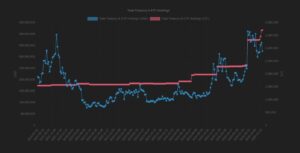The swift collapse of the United States’ Silicon Valley Bank is the largest since the great financial crisis in 2008.
The precipitous downfall caught regulators off guard and showed underlying weakness in the entire traditional banking sector, as contagion and panic spread throughout Europe, the UK and elsewhere. Depositors who store funds on fractional reserve banks are now left wondering whether their money is really there, or if the gig is up. HSBC’s UK arm acquired the bank in what’s effectively a ‘bail-in’ and the US Federal Reserve began a process of stealth quantitative easing as the crisis worsened.
Here’s the long and short of it:
- At the end of 2019, Silicon Valley Bank’s deposits expanded from $61 billion to $181 billion by the end of 2021. This is due to its startup customers raising a deluge of venture capital funds.
- The capital raise was too good to be true; Silicon Valley Bank wasn’t able to lend these deposits out fast enough, so it started looking for other options.
- These other options included a large chunk of long-dated mortgage-backed securities (i.e., maturities in excess of 10 years). Silicon Valley Bank put 56% of its assets into fixed-rate securities, which is much higher than most banks.
- The bank was effectively betting heavily that interest rates would not rise the way that they ended up rising. As we know, the opposite happened.
- As interest rates surged – one-year Treasuries, for example, went from yielding around 0.05% (on May 31, 2021) to yielding over 5% today. As such, the values of those Mortgage-backed securities (MBSes) fell precipitously.
- Moody’s downgraded the Silicon Valley Bank.
- Concerned stakeholders like Peter Thiel advised VCs and other portfolio companies to withdraw their capital. Account holders had already been withdrawing deposits in 2022 as funding slowed down. As such, convincing them to withdraw wasn’t a difficult task.
- This created a feedback loop. Silicon Valley Bank has to sell assets at fire-sale prices to respect redemptions.
- The Bank told depositors that it was operating as normal “we’re okay”, they said, when they were very much not okay. Word got out and this made the panic worse – everyone headed for the exits and the last depositors to cash out were left holding the biggest bag of odorous excrement ever assembled in the history of banking.
- With $209 billion in assets, Silicon Valley Bank, turned into the second-largest US bank failure of all time. FDIC insurance only covers $250,000 in deposits, but as Silicon Valley Bank is a business bank – as such less than 3% of its deposits were covered.
- Incidentally, with $620 billion in unrealized losses at other US banks, people are worried about a similar fate at other small, undiversified banks, and bank stocks are tanking overall.
- HSBC has since acquired the failed bank, and the Federal Reserve has restarted money printing to “address any liquidity pressures that may arise” that depositors get their money back. Of course, quantitative easing will have problems of it’s own (inflation), reigniting the case for hard assets like Bitcoin in an already high-inflationary environment.
If ever there was a story that epitomised the absolute case for Bitcoin, incessant traditional bank failures are surely it.
By restarting money printing, the Federal Reserve is signalling that it is more worried about contagion in the legacy financial system than it is about inflation.
Join the telegram channel for updates, charts, ideas and deals.
Did you like the article? Share it!



